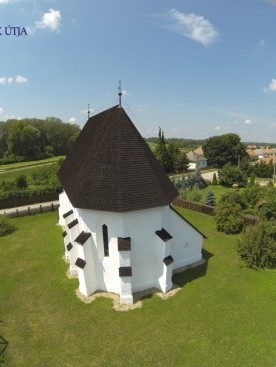Calvinist church in SzamosújlakThe first written mention of the name Újlak, in the form of Wylok, dates back to 1314. A document from 1329 reports the completion of the construction of a church dedicated to Saint John the Baptist, which was probably built by the Zombok family of the Gut-Keled generation, and to whom the village belonged since the 13th century. Its name is already mentioned in a papal tithe list from 1332, which is an indication of a functioning parish. Around 1545, the people of Szamosújlak adopted the Reformation from the group of reformers residing in the court of Gáspár Drágffy in Erdőd. Between 1589 and 1596, the Catholics and the Reformed living in the village strived for the church. At first, it was altered to a puritan church by the Reformed, and following that, it was reconstructed by the Catholics. Finally, the church became the property of the Reformed, and after some time, the people of the village also converted to Reformed religion. The early Gothic style church is located behind the embankment of the river Szamos, on the outskirts of the village. Despite the reconstructions implemented later, its layout and character originating from the early 1300s are clearly indicated. The sanctuary closing in three sides of an octagon is attached to a square-based towerless nave by a triumphal arch. The church almost entirely preserves its medieval form. It was built in the Middle Ages, in two construction phases. According to the polygonal closing of the sanctuary, it is probable that the first construction phase was implemented not much earlier than the late 13th century or the early 14th century. As a result, it is possible that the present building is the same as the church of Saint John the Baptist mentioned in 1329. To the northern side of the sanctuary, the approximately square-based vestry is attached, which is the reconstruction of the previously demolished part of the building. The vestry and the sanctuary are linked with a Gothic style stone-framed door. In 1857, the new wooden tower of the village was consecrated, which regrettably did not have a long life. Due to a fire, which broke out in the teacher’s house, the church burned down, together with most part of the village, on July 10, 1865. One of the bells was also destroyed at that time. During its reconstruction in 1867, a simple belfry was constructed beside the church. On the western and eastern side of the church’s interior, blue-painted wooden galleries can be observed. They are very simple and almost ornamentless. They were created together with the furnishings of the church in 1867. The old sanctuary featured a Welsh vault. It was converted to a groin vault with a pointed Gothic profile somewhere in the early 16th century. It is probable that the steeply curved roof structure of the church was destroyed by the fire in 1865. As a replacement, a characterless, flatly-arched roof structure was built, whose wood material decayed during the years, and the covering made of tin suffered water leakage in many places. With the assistance of the National Office of Cultural Heritage, the church was restored between 1992 and 1996. During the excavations and wall researches, a great number of data was gained. It was problematic that no authentic documentation was available with reference to the original roof structure. As a result, according to the still existing roof structures of the similar churches in Hungary, a new structure featuring trusses and having the elements of the original structure was installed, which is a unique sight. The exemplary restoration was awarded the Europa Nostra certificate, which brought attention to the heritage protection of the region and the county. |













